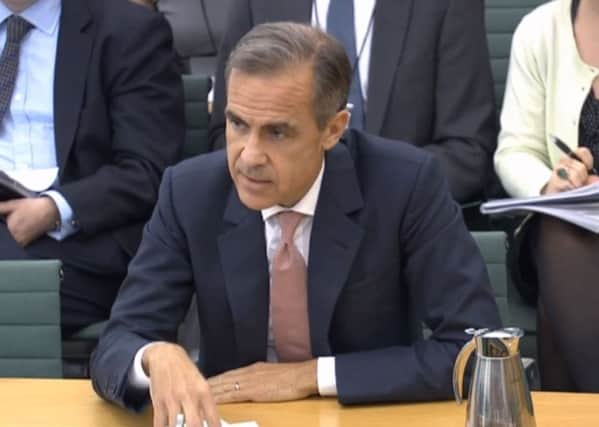Motley Fool: Don’t hold your breath over interest rate rises


Regular readers with long memories might recall that back in March 2009, just after the Bank of England cut Bank Rate to a historic low of 0.5 per cent, I wrote that a rise in interest rates was probably a year away.
A year later, in 2010, I wrote that once again, analysts and forecasters were predicting that a rise in interest rates was probably a year away. Likewise, that was once more the consensus in 2011. And in 2012 – but enough. You get the picture. For most of the past six and a half years, it seems that a rise in Bank Rate has been a year away.
Advertisement
Hide AdAdvertisement
Hide AdUntil this July, that is. Because that was the point at which Mark Carney, Governor of the Bank of England, finally signalled that he saw it likely that interest rates would begin rising again later this year. That is, to start rising around now.
And because the Bank is seen as traditionally reluctant to raise interest rates in December, the moment of truth came last Thursday. Dubbed ‘Super Thursday’, because it also saw the scheduled publication of a slew of monetary and inflation statistics, it resulted in the Bank back-pedalling furiously from the viewpoint that Mr Carney had expressed as recently as July.
No, interest rates wouldn’t be rising this year. Not with the Bank’s Monetary Policy Committee once again voting 8-1 to keep them unchanged. And no, they wouldn’t be rising any time soon, either – not with weakening global economies and inflation as close to zero as makes no difference.
So when will interest rates rise? The simple fact is that no one knows. Certainly not Mr Carney, whose track record in issuing the sort of ‘forward guidance’ that we saw in July has been fairly lamentable.
Advertisement
Hide AdAdvertisement
Hide AdLast year, for instance, Treasury Committee member Pat McFadden MP publicly lambasted the Bank – and its Governor – as “behaving like a sort of unreliable boyfriend”.
Businesses and consumers had been “left not really knowing where they stand” by statements made by the Bank, he added. Nor has the Governor’s press improved of late.
“Clueless Carney blows hot and cold on interest rates,” is how The Times memorably summed up Thursday’s events. But frankly, I wouldn’t be over-optimistic that a rise will occur next year. Some observers, such as Fidelity’s Tom Stevenson, have looked at the Bank’s latest numbers and see a distinct possibility that a rise could be as far away as 2017. And even then, it will only be a gentle rise.
Why does all this matter? Because, quite simply, the return on cash savings has been derisory over the past six and a half years. And sometimes that return has been negative, in real – inflation-adjusted – terms, during those periods in which inflation exceeded the interest rates that our cash earned.
Advertisement
Hide AdAdvertisement
Hide AdBefore the recession, savings banks were paying generous interest rates of 5 per cent or more. Back then, it was possible to think in terms of living off cash savings in retirement, or using the earnings from cash savings as a second income.
Not any more. The next move might even be down. The present post-crash financial expansion is already long in the tooth. Markets and economies bottomed out in early-to-mid 2009, and have been recovering steadily since.
So it might be that all this talk of interest rate rises being a year in the future is once again premature. Because if an economic downturn comes along, not only won’t interest rates be rising, but they could actually be cut – a possibility that Mr Carney also alluded to on Thursday. Meaning that a rosy vision of living off cash savings in retirement, or using the earnings from cash savings as a second income, recedes even further into the long grass.
I said it before and I’ll say it again: the charms of decent, blue-chip, dividend-paying stocks are hard to beat. Solid businesses such as banking giant HSBC, currently yielding 6.0 per cent; or GlaxoSmithKline, yielding 5.9 per cent; or BAE Systems, yielding 4.7 per cent.
Advertisement
Hide AdAdvertisement
Hide AdEnergy and mining stocks are offering especially juicy yields, although some have question marks over their dividends’ sustainability. But Royal Dutch Shell has a dividend-paying record going back decades, and yields 6.9 per cent. Centrica, the owner of British Gas, pays 5.3 per cent.
So if you’re seeking income, my view is that savings accounts have little to offer over the next few years. Tuck away a few decent dividend picks, instead.
The Motley Fool provides investment research and commentary at Fool.co.uk
The company’s name was taken from Shakespeare, whose wise fools both instructed and amused, and could speak the truth to the king without getting their heads chopped off! The Fool has spent decades championing shareholder values.
You can look forward to our fortnightly column every other Saturday here at The Yorkshire Post, or visit Fool.co.uk